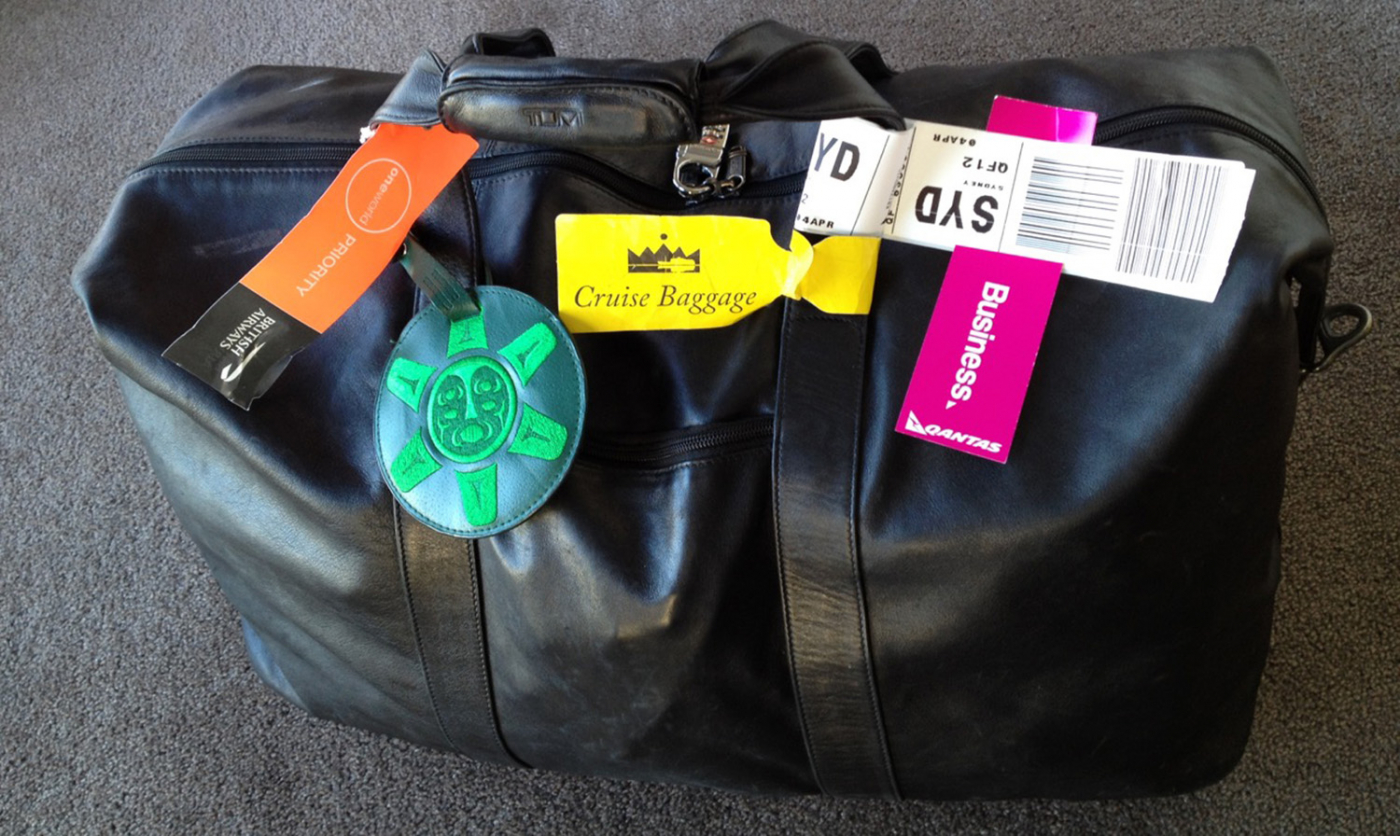
Tumi ache | “I don’t have kids. I have luggage”
Why Karen Krizanovich likes to travel with her Tumi above everything else

Why Karen Krizanovich likes to travel with her Tumi above everything else

I’m standing there, watching the wheel go round and round and see a black leather satchel circling towards me. It’s gorgeous and smart and I wish it were mine.
Oh wait. It is.
“Hey that’s my Tumi!” is what I want to say out loud, but I don’t because then I’d have to kill myself.
The reason I own this bag is I don’t want to see a clutch of cheap thongs splayed along the baggage belt and know those thongs are mine. Ever since 1974, Tumi’s been coming around the mountain with luggage that won’t leave your pants on the carousel. Of course, I’ve got beautiful handmade springbok bags from Namibia that I love using, as well as monogrammed LL Bean canvas totes, designer hardshells and large vintage hand-me-down cases. But, like a lover who is too good to be true, I keep circling back to Tumi even if I have to crack serious plastic to get more. Not that I need more, but I love that damned black ballistic nylon as much as John Gielgud loved corduroy.
According to its president, Jerome Griffith, “If you travel Business or First class, you’ve seen us.” This implies that if you’re like Zoolander and you can’t turn left, you could still get that ambi-turner feeling by buying a Tumi product. It’s a little stroke of marketing genius backed up by a lot of goods. Not that every bag’s a winner. Years ago, I bought one with a U-shaped zipper (a shape instigated by Tumi founder Charlie Clifford in 1983). It clamped down on my arms like a set of teeth every time I tried to pack it. This model is no longer for sale, but that error is part of the brand’s refusal to be “design fixed”, i.e. allowing design trial and error. Calling itself “the premiere travel and business accessory company”, Tumi is designed mainly for well-heeled grumpy geeks and irritable businessmen but mingling with its bestselling black business wheelies are DJ backpacks and a Tegris hardshell, made with NASCAR material strong enough to sit on.
“Any cow with money can buy a Gucci shoe… but this one belongs to the real lady, who has Gucci foot”
So, how do you get that left-turn feeling? Try the popular Tumi 22061– the Continental Expandable Four Wheeled Carry-On from the Alpha 2 range. It costs £675.00 (or, ahem, $675 for lucky Stateside shoppers) but at 56 x 40.5 x 23cm, it is the largest size allowed onboard. There’s no guarantee that it’ll fit every flight you take, but it’s suitable for the more depressing airlines, including easyJet. A Tumi carry-on says “I’m successful” and it gets you away so quickly no one will notice that you’re actually too poor to have one. Sort of like the line from Dusan Makavejev’s Montenegro – “Any cow with money can buy a Gucci shoe… but this one belongs to the real lady, who has Gucci foot.”
The marketing force is strong in this one. You do feel superior using the stuff. In their only mildly pretentious YouTube Case Studies, potential customers can learn valuable things like preventing jackets from wrinkling by packing them turned inside out and that Tumi, named after a ceremonial Peruvian knife, makes suitcases that are knife-proof. Santa Claus likes the brand too, which is a bit predictable given Tumi’s past hookups with Ducati, Lexus, Delta, United Airlines, Dell and other brands you’ve had Twitter arguments with.

The Continental Expandable Four Wheeled Carry-On by Tumi
A recent big profit report shows some canny management of a 40-year-old brand — not many celebrity associations, direct sales and great store staff. According to one of the many shop managers I’ve badgered, the luggage you see in the shop may look samey, but “It is only on closer inspection that you see 30 improvements and 14 patents. It’s only when you start to use the product you understand how much work and care has been taken.” I checked. He’s right.
They can’t be knifed. They’re discreet
Online forums suggest the brand has lapsed since its sale in 2004. Those isolating a cost-to-function ratio snarl at it too, saying it’s heavy and pricey and that there are better on the market. All true. You shouldn’t take a broken Tumi back to the shop and expect it to be like asking your mom for money. You will need a receipt and the guarantee is not as all-encompassing as, say, Briggs & Riley’s lifetime warranty or Eagle Creek’s three-level option. Then again, those bags are ugly.
Why not a Rimowa, Hartmann or Vuitton? Ignore that the latter two hilariously list all the movies they’ve appeared in, whereas the only Tumi fan in the movie industry seems to be the propmaster of Sean Penn’s disastrous This Must Be The Place.
Avoid ostentation. Tumi isn’t the cheapest or the lightest or even the best designed for dragging over rocks, but look at it this way – you want your bag to be everything you can’t be. Tumi ages well. Each piece has a tracer tag. They can’t be knifed. They’re discreet. For the cash poor, it pays to have a bag that speak for you, especially one that says you turn left. C